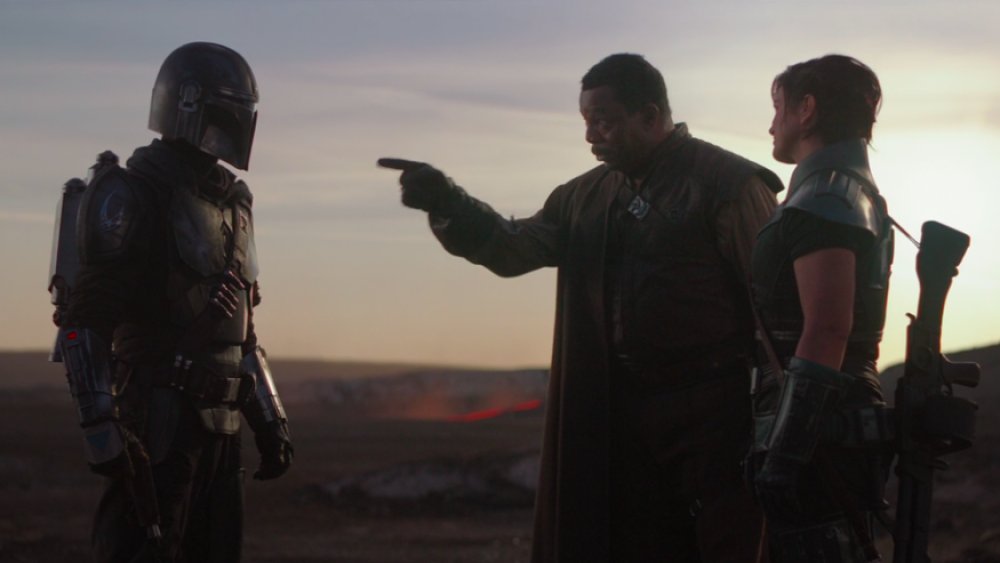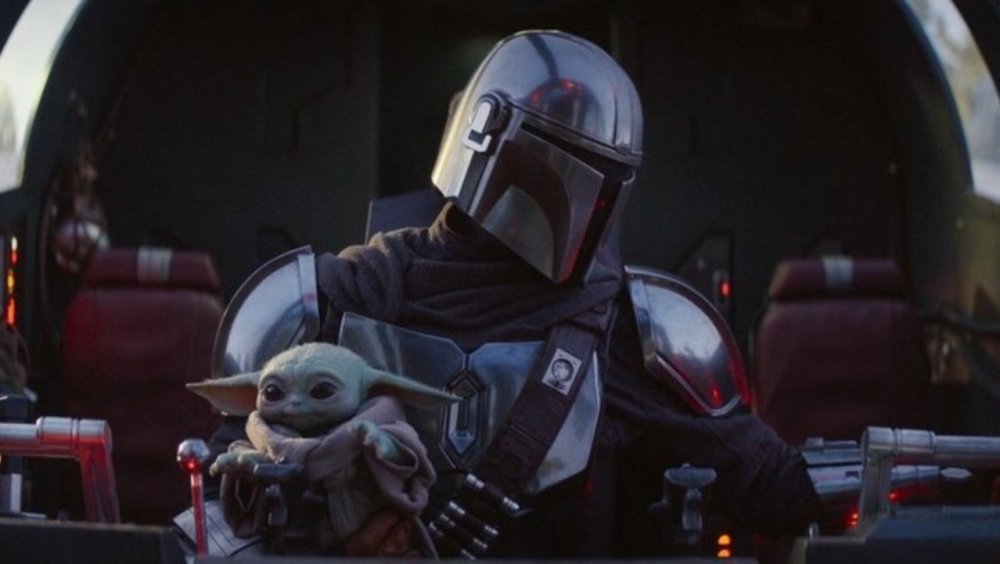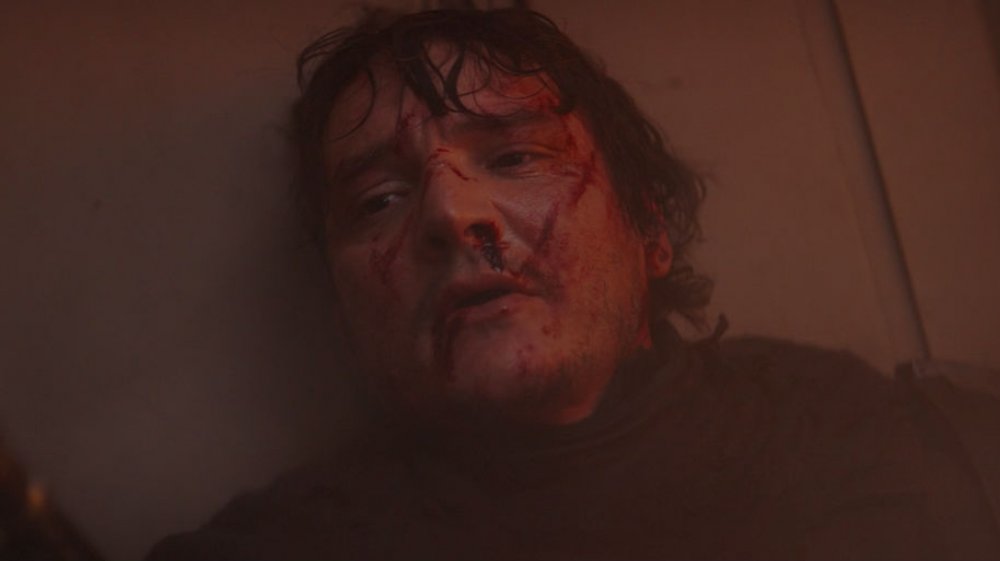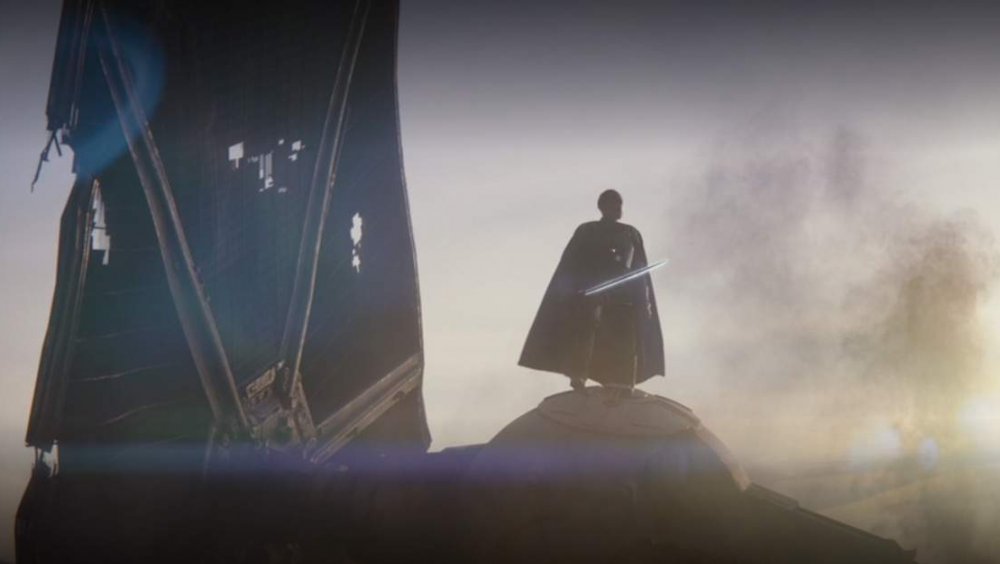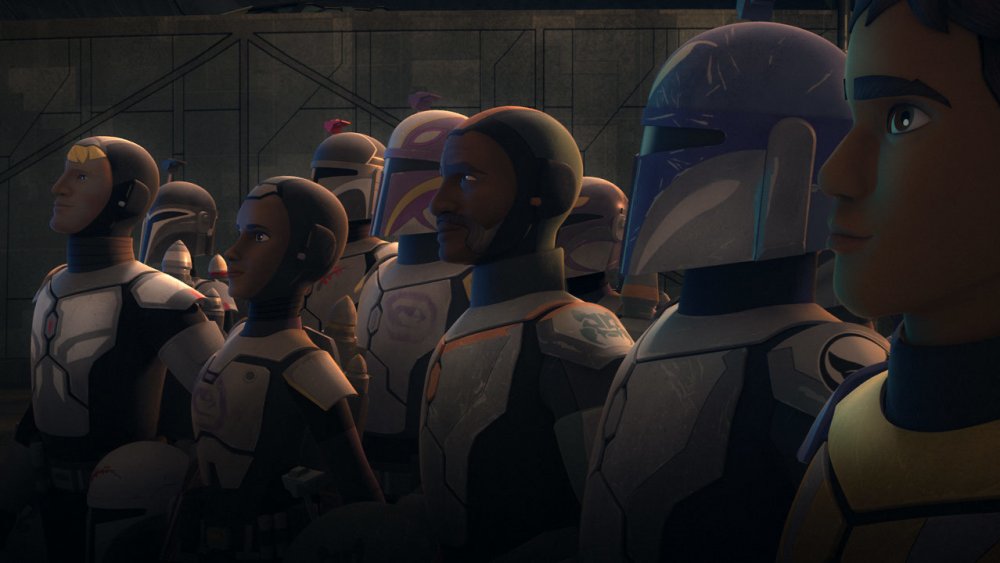The Ending Of The Mandalorian Chapter 8 Explained
Contains spoilers for The Mandalorian chapter 8, "Redemption"
The great big galaxy has opened up to pour over Mando, and he doesn't even know it. The finale of The Mandalorian's inaugural season proved to be a massive Pandora's Box of lore, paving the way for all the future conflict to define Mando's return in the second season (which is currently filming, don't worry).
Entitled "Redemption," chapter 8 of the live-action Star Wars series makes for one big death-defying fight for the Mandalorian (Pedro Pascal) and his friends as they try to break free from Moff Gideon's (Giancarlo Esposito) grip on them on Navarro. Desperate rescues, sudden revelations, and heart-breaking loss shift this episode away from mere explosive action and into the densest episode of the season.
Now that we're at the end of the first season of The Mandalorian — and the first official, major foray post-Skywalker canon — the spread of the story at hand for Mando has widened exponentially and begun suggesting ties back into other preexisting canon content. For the first time all season, The Mandalorian puts its tangible footprint down relative to the complete Star Wars timeline and seeks to annex deeper canon of its very own.
Let's take a look at how much bigger Mando's story has become and what it will mean for the next hotly-anticipated season, whenever it arrives. As always, major spoilers are ahead.
The ascendant Mando
Within action-packed shell of The Mandalorian chapter 8, a rich, succulent nugget of characterization for Mando was slowly revealed. His brush with death gave us the first opportunity we've ever had to actually see Pedro Pascal in his role as the Mandalorian, when IG-11 (Taika Waititi) removes his helmet to save his life under the amusingly convenient technicality that the droid isn't a living being, which means Mando wouldn't wound his honor if he reveals his face to IG-11. It's a deeply humanizing moment for our hero (whose full name has now been spoken on-screen) to show his face in his most desperate moment, visibly frightened and lost like any other person in the face of death. Additionally, it's particularly special because IG-11 came to represent a mirror for Mando and the kind of man he used to be.
After a little help shaking off the grim reaper, Mando had bestowed upon him an official signet to represent his complete identity within the Mandalorian creed, and finally got a slick jetpack of his very own. Being of no traditional Mandalorian clan himself, he has become his own collective unit with the Child (a.k.a. Baby Yoda) as a Clan of Two, and was given his mission: return the Child to where he belongs — that being the Jedi, according to their theory — or otherwise raise the Child unto his adulthood, if the foundling has no home to return to. We know what happened to the Jedi, and what's more, we understand that the Jedi aren't the Child's people to begin with, speaking particularly towards species. If the Child belongs anywhere, it's with Mando — but again, that's the overarching emotional journey we're going on with our favorite chrome-domed himbo as he continues fully realizing that.
Chapter 8 of The Mandalorian was mainly about taking all of the subtext of Mando and the Child becoming a familial unit over the past seven episodes and turning it into text with big block letters for everybody to get on-board with. Along with that, Mando gained the tools and status he needed to finish the transition from hunter to protector — and a whole human being with feelings, at that. It isn't his destiny to die the warrior's death he first insisted on — it's to live and be the parental figure he never had the joy of receiving.
The revelation of Din Djarin and his relationship to Moff Gideon
Underneath his Mandalorian armor, the character fans have fallen in love with over the course of the series' first season is named Din Djarin. Mando's canonical name snuck out into the public eye some weeks ago, so you may have already heard it if you were paying attention, but at the end of the day, his true moniker isn't of any terrible consequence or meant to be a forbidden secret. The importance in revealing his name now on The Mandalorian chapter 8 is both to underline just how dangerous Moff Gideon is, and also to compound the humanization of Mando's character that occurs within the episode. Nobody hanging out with him on-screen needs to call him by his name, but we should hear it in this particular episode's context, after we've learned many of this man's deepest truths and see him at his temporary lowest.
Moff Gideon likely knows very little about Mando as a person and only knows his name because it's on an official governmental list on Mandalore, but Moff and everything he represents makes for the perfect kind of pre-packaged Instant Villain for our helmeted hero. Moff is directly representative of the Mandalorians' galactic genocide and the society that robbed pre-Mandalorian Din Djarin of his original family, which we have finally gotten to witness in its totality — and that's before we even get into the threat the governor represents to the Child. Truly, Moff Gideon is the spectre shadowing Mando's entire existence as a person consistently robbed of a permanent home and family. It's perfect narrative poetry: this is the thing and person from which Mando must defend his new, tiny clan.
The Darksaber
On the season 1 finale of The Mandalorian, Moff Gideon emerges from his wrecked TIE fighter — because of course he was going to, we know how this works — and reveals the real twist by holding the mythical Darksaber. That sure was a last-second lore drop, wasn't it?
For those unfamiliar, the Darksaber is an ancient lightsaber dating back over a millennium. The handmade weapon of the first Mandalorian inducted into the Jedi Order, the Darksaber was stolen in the midst of the Old Republic's (not the Prequels' republic — we mean Bioware's video game The Knights of the Old Republic-republic) slow, war-ridden demise and then returned to Mandalore. It stayed there for centuries to become a generational token passed down to descendants of the Viszla clan that once ruled the home planet. Very, very long story short (watch the Star Wars: The Clone Wars and Star Wars: Rebels animated series for the whole narrative), when the Empire fell, the Darksaber was in the possession of a Mandalorian woman named Bo-Katan Kryze, leader of the pro-Republic Mandalorian forces. However, that's where the trail ends — just before the Battle of Yavin and the official fall of the Empire, somewhere between eight and 10 years prior to this episode of The Mandalorian. Bo-Katan Kryze obviously no longer possesses the Darkssaber, and we can only assume she would give it up over her dead body. Ominous, huh?
The current state of Mandalore
It's a curious turn for the Star Wars franchise to pass the lore baton from an animated series back to a live-action one in such a big way, and onto such an utterly blank page, too. This is doubly true where you consider that The Clone Wars and Rebels were primarily aimed at children and The Mandalorian really isn't — like at all. When the Empire fell, Mandalore was in a state of civil war (a common thing, historically speaking, for Mandalorians). No further canonical information exists, so The Mandalorian is gleefully seeking to fill those pages up on its own terms. This is no small side story anymore — the show will enter a new phase in its second season as a full-throated, major piece of canon thanks to the Darksaber reveal.
If Kryze is indeed dead and the Darksaber has been stolen from its people, what's the political state of Mandalore, post-Empire? The Republic-led forces under Kryze seemed to be on the ascent along with the rest of the Rebellion, but the heart of the conflict for the Mandalorians in the past several canonical decades was whether or not to become more pacifist and relinquish martial culture. How much does that matter to the plot of The Mandalorian? And how in blazes did an Imperial Remnant governor get ahold of the MacGuffin that the Darksaber represents? We'll be sitting on our hands for the next several months waiting to find out when the second season of The Mandalorian arrives (hopefully) sometime in 2020.
